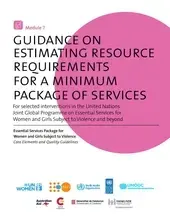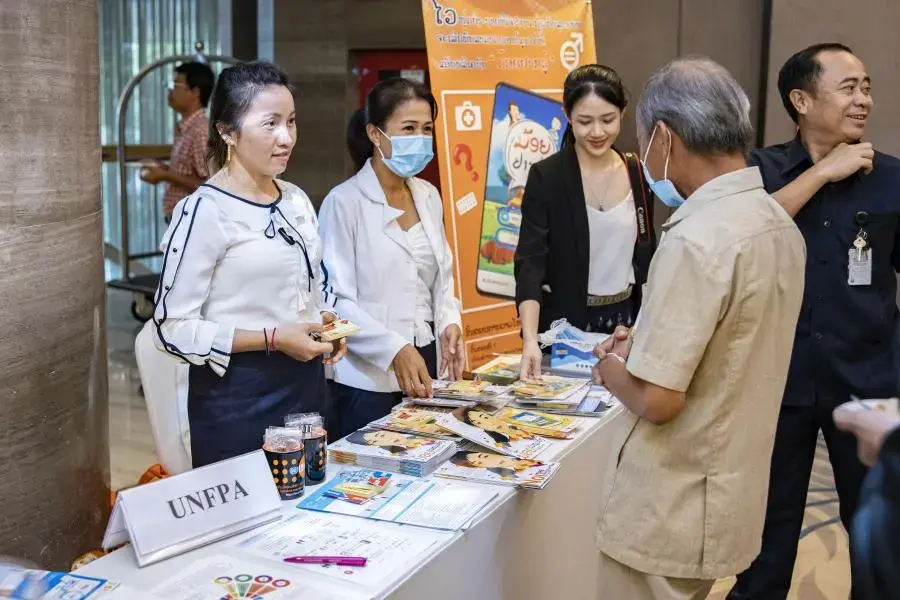-Vientiane capital, 14 July 2021 - The Ministry of Planning and Investment (MPI) in collaboration with the United Nations Population Fund (UNFPA) and the Swiss Agency for Development and Cooperation (SDC) launched this morning the UN Joint Programme on “Protection and Services for Vulnerable Settlements, Migrants, and Youth in Savannakhet and Champassak”. The virtual event was chaired by H.E. Mme. Phonvanh Outhavong, Deputy Minister of the Ministry of Planning and Investment, and co-chaired by Mr Jean-François Cuénod, Regional Director of Cooperation of SDC, and Ms. Mariam A. Khan, UNFPA Country Representative.
In her opening remark, H.E. Mme Phonvanh Outhavong, Deputy Minister, Ministry of Planning and Investment stated: “I would like to thank UN Agencies (UNFPA, IOM, and UNHABITAT), especially SDC, who provide financial support for this joint programme. I extend my appreciation to Line Ministries, particularly the Ministry of Health and Ministry of Labor and Social Welfare for your collaboration to make this UN Joint Programme happen.”
The COVID-19 pandemic has disproportionately affected marginalized and vulnerable people such as migrant workers, women and girls, and people with disabilities. Women make up nearly 50% of migrants in the Greater Mekong Sub-region, and a significant proportion of these are girls in the 15-24 age group. Women migrants in general have lower levels of education and earn significantly less income than their male counterparts. The COVID-19 outbreak has caused a high number of migrant returnees who are living in temporary shelters, quarantine centers and similar settings. The vulnerability of these returnees is likely to be increased due to difficult living conditions characterized by a lack of good hygiene practices, insufficient food and nutrition, lack of opportunities for work, and limited medical care, including limited access to sexual and reproductive health services for women and young people.
This Joint Programme contributes to tackling the health and socio-economic crisis caused by COVID-19 by supporting and enabling the government and programme site communities in Lao People’s Democratic Republic to enhance their resilience. Savannakhet and Champassak were identified based on the high number of migrant returns since the outbreak of COVID-19, as the most frequented migration corridors for Lao workers, as well as population density, presence of young population, and vulnerability conditions, among others. The project will assist people living in vulnerable settlements and camps, strengthening mechanisms to enable people to restore livelihoods, health, and well-being.
Mr. Jean-François Cuénod, Regional Director of Cooperation, SDC said “As we have seen in the last days, the number of returning migrants from Thailand is increasing, so this project is all the more timely.” He added that “The project will also contribute to enable the government and communities to enhance their resilience and improve their coping capacity as a longer-term response to the health and socio-economic crisis caused by COVID-pandemic.”
Ms. Mariam A. Khan, Country Representative, UNFPA said “I appreciate the Ministry of Planning and Investment for coordinating this new constellation of partners and thank SDC for encouraging us to embark on this partnership.” Ms. Khan emphasized that this joint program initiated after Wave I of COVID in Laos, is highly relevant to the evolving Wave II, “ we have already adapted in response to the changing context. Subject to the scale of COVID-19 Wave II, especially in target provinces, if required the plan will be further adjusted. UNFPA as lead agency is committed to delivering optimal results” she added.
This new collaboration of 3 UN agencies and multiple Line Ministries and other partners will collectively reach an estimated 172,000 direct beneficiaries, - of which 101,160 women - including migrant returnees, internal migrants, displaced or stranded migrants and victims of human trafficking, adolescents, youth, gender-based violence survivors, and residents in two provinces. Around 600,000 people are estimated to benefit indirectly from the programme. New synergies are being stimulated amongst the diverse partners in the capital and on the ground.
Ms. Shareen Tuladhar, Chief of Mission, IOM said “we will serve the vulnerable communities and also strengthen the capacity of community radio staff and volunteers to provide accurate and timely information, education, and resources to their communities.”
Dr. Avi Sarkar, Chief Technical Advisor, UN-Habitat said “UN-Habitat’s main activities, will focus on providing improved WASH infrastructure and services such as public hand washing stations, temporary water points, and other on-site sanitation facilities accessible by all vulnerable groups, such as children, youth, elderly, disabled, women, migrants and ethnic minorities.”
The partnership between the three UN agencies is based on their comparative strengths and will build on existing collaboration with the Government of Lao PDR, implementing partners including the Ministry of Health, the Ministry of Labor and Social Welfare, Nam Papa State Enterprise, Lao Youth Union, Lao Women Union, and civil society partners. The joint program will be implemented for a period of 18 months,with a total budget of USD 1,389,470.00, of which the contribution from SDC is USD 998,970.00.
For more information please contact:
Mr. Sysomphorn Phetdaoheuang,
Director of Department of International Cooperation, Ministry of Planning and Investment
Ms. Natalia Wiik,
SRHR and AYFS Consultant
UNFPA Laos




